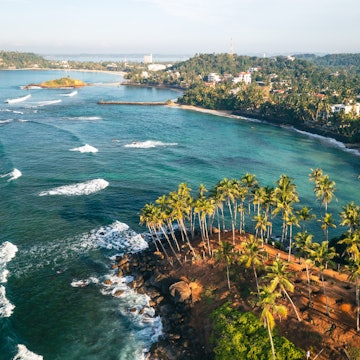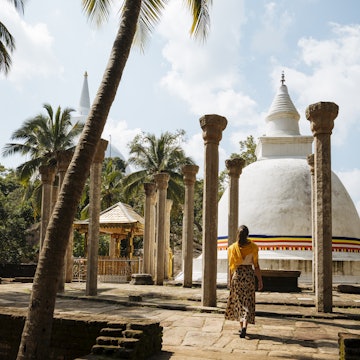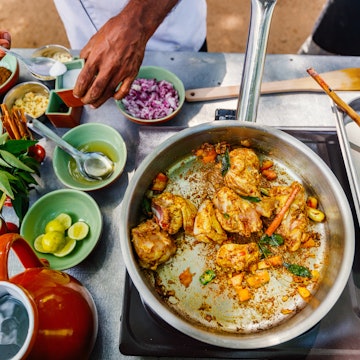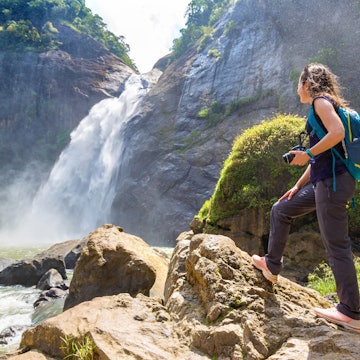

Sri Lanka's mountain railways slice through emerald hills. Milan Chudoba / 500px / Getty Images
After a tumultuous two decades of political instability and civil war, calm has returned to Sri Lanka, and visitors are flooding back. This Indian Ocean island has a deserved reputation as a top spot for adventurous backpackers, but going for a family holiday – was that a step too far?
As a travel writer, I needed to find out. Luckily, my wife loves adventure, and the kids were happy to come along for the ride, so we set out in search of the perfect Indian Ocean family holiday.

Why Sri Lanka?
With so many tropical islands to choose from, what made us pick Sri Lanka? For the variety more than anything. On our journey around the island we marvelled at ancient palaces, snorkelled on coral reefs, watched great herds of elephants and strolled barefoot on tropical beaches. Few places offer so much in such a manageable area.
Then there was a sense of passing things on to the next generation. In the years BC (before children), my wife and I travelled widely in India and Africa, and we hoped to share a similar experience with the kids – aged 12 and 15 – but without the tears or fears. What we wanted was easy travel, good-value accommodation and no hassle, and Sri Lanka ticked all the boxes.
First steps in Negombo
The children were a little unsure what to expect, but it was in Negombo, just north of the capital Colombo, that they had their first rickshaw ride, their first taste of a genuine, at-source South Asian curry and their first sight of the Indian Ocean. It was wonderful to experience travel in the developing world through the eyes of our (very first-world) children, Days were filled with questions: 'Dad, why does the rickshaw have no seatbelts?' and 'Dad, why are there cows in the road?'.
Negombo served up an education in Sri Lankan history as well. European powers have influenced Sri Lanka for 500 years, and in colonial times, the British filled the island with railways, the Portuguese built the churches and the Dutch, of course, built the Hamilton canal – which is still in use connecting Puttalam to Colombo. In seemed only appropriate to take a boat ride along this historic waterway depositing us at the unmistakably European St Mary’s Church, one of the many that give this city its ‘Little Rome’ moniker.
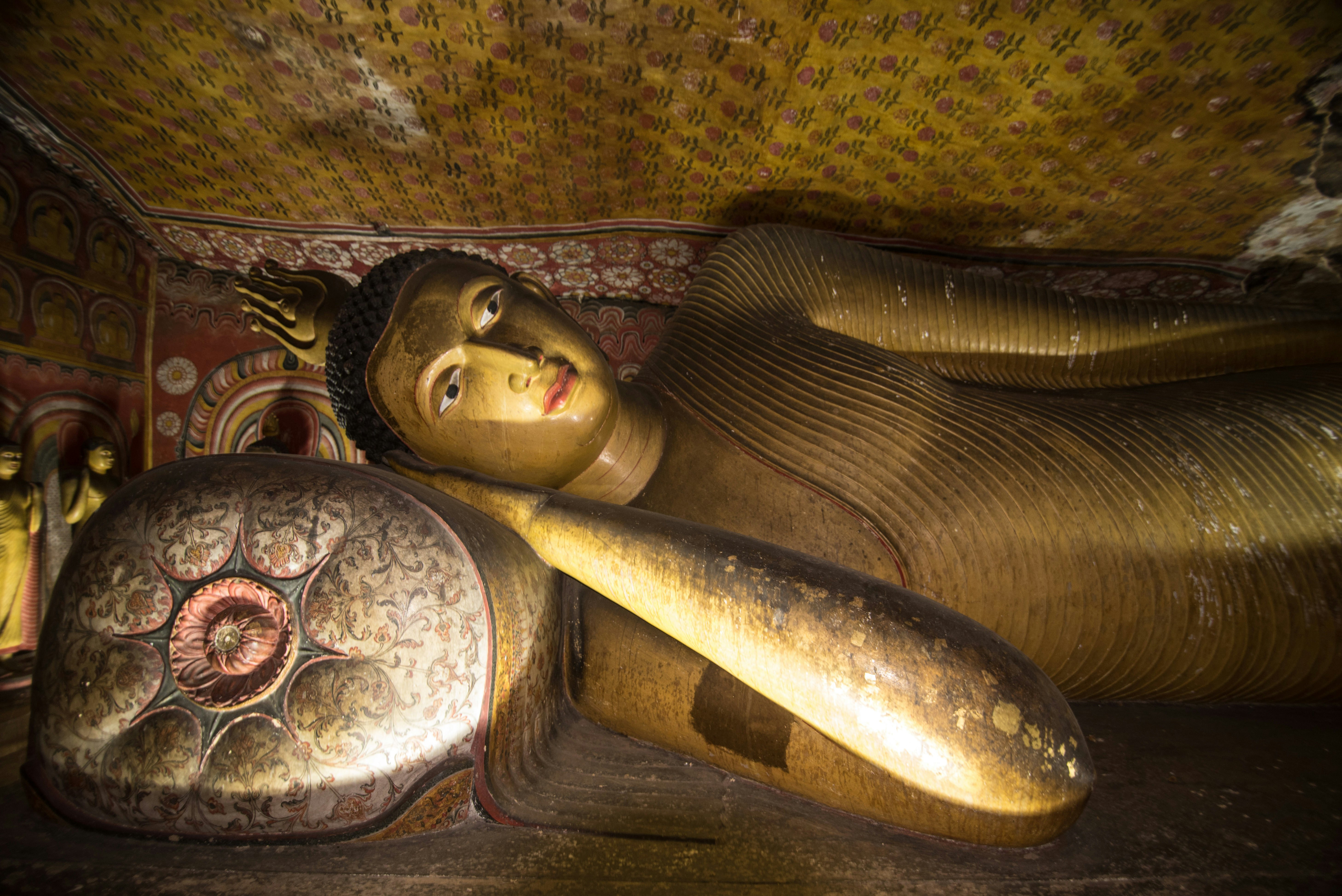
Heading up-country
Journeying inland and farther back in time, our next stop was the complex of Buddhist cave temples at Dambulla, where natural caverns were filled with statues of the Buddha over many centuries, as local kings attempted to out-perform their predecessors with increasingly large and elaborate figures of the great teacher.
Most impressive of all was Dambulla’s gigantic reclining Buddha, where just the statue’s toes were larger than a 12-year-old boy’s head. We know because he checked. It was very rewarding to see our own enthusiasm for history and culture being picked up by our children.

Cultural triangle
The countryside around Dambulla is dotted with an abundance of temples and historic sites, hence its nickname of the Cultural Triangle. But the key to success for family travel, as every parent knows, is to not be too ambitious. Experience had taught us to focus on just a few places, rather than risk exhausting young minds and bodies by trying to see everything (something that only really works in Disneyland).
Rather than line up a string of temple tours, we opted for one more stab at history in Sigiriya, a vast ruined palace on a towering rock, soaring above the surrounding plains. It’s a Sri Lankan icon, made all the more captivating by the landscaped water gardens at the foot of the rock and the delicate frescoes painted on the cliffs.
The palace was built around 1500 years ago but eventually abandoned, to be rediscovered and researched by archaeologists in the 19th century. Science fiction readers of a certain age will know it from Arthur C Clarke’s Fountains of Paradise; for our kids, tales of lost palaces inevitably inspired thoughts of Indiana Jones, and this became a theme for our explorations.

Pachyderms on parade
After several stops with an educational bent, it was time for a break from culture and history, and Sri Lanka served up its next family-friendly delight in the form of wildlife. In an open-topped safari jeep we trundled into Kaudulla National Park, where vast herds of elephant emerged from the forest to drink at a shallow lake.
The kids were entranced by their first sight of elephants in the wild, but having experienced safaris in Africa, Kaudulla wasn’t really a wilderness experience. Along with neighbouring Minneriya National Park, this is a hugely popular spot for tourists, with humans sometimes outnumbering the animals. Despite the proximity, on our visit the elephants seemed undisturbed by the vehicles, but some travellers have found the overcrowding off-putting.
Beach hut living
We’d promised the kids beaches, so we continued our journey northwards towards Trincomalee and Uppuveli, once a sleepy fishing village but now a fledgling coastal resort, where we stayed in palm-thatched cabins just a minute’s walk from the beach.
A staple of the backpacker experience, beach hut living was perfectly suited to family life. Swimming, paddling and lounging on the sand were the primary activities of the day, interspersed with periodic trips into town to see astoundingly decorated Tamil Hindu temples or haggle for souvenirs in the market.
Plentiful wildlife offshore provided more family bonding experiences: an early-morning boat-ride to watch dolphins frolicking in the waves and a snorkelling-trip to nearby coral reefs where the kids enjoyed swimming among shoals of the brightly-coloured tropical fish. Yes, including some that looked like Nemo.
After a day of activity, evenings were a calmer affair, usually spent in one of the laid-back restaurants overlooking the ocean, where we would drink from fresh coconuts and feast on fresh seafood. Menus were well set up for families, allowing grown-ups to sample spicy local dishes while the kids relaxed with a pizza. As veteran travellers, we always try to encourage the kids to sample new food when travelling, but sometimes they just want something familiar. Fair enough – it’s their holiday too.
Tea and trains in the hills
The final leg of our journey back to Colombo sliced through the Hill Country at Sri Lanka’s heart, where we stayed in a cottage on one of the many historic plantations that produce the island’s world-famous Ceylon tea. There was just time for a pocket-friendly ride on the equally famous historic railway that meanders through the mountains, but this was just for nerdy dad; my wife went bird-watching, and the kids stayed in the cottage, making full use of the wi-fi.
And so the journey ended more or less as it had begun, with a final look around Colombo before jetting home. Our conclusion? Sri Lanka provided everything needed for a low-stress, good-value and hassle-free family holiday, plus enough adventure to keep the adults on side. The only challenge, in our experience, was keeping to our promise to not cram too much in.

Practicalities
To ease into the trip, we booked ahead at a guesthouse in Negombo with easy access to Colombo airport. The remainder of our accommodation ranged from comfortable midrange hotels to simple beach huts, but at each stop we arranged a car and driver to take us to our next destination, ensuring comfort, flexibility and reduced travel times – thereby avoiding cross and frustrated kids. For getting around towns and cities, three-wheeler auto-rickshaws, known as tuk-tuks by tourists (but not locals), added local colour and fun.
Lunches were mostly bread and bananas bought at road-side stalls, but for evening meals we ate at our hotel or a local restaurant; ‘devilled calamari’ was a particular cross-cultural favourite. For drinking water, we avoided disposable plastic as much as possible and filled our own bottles with tap water purified by Steripen. We were fastidious about hand-washing, which seemed to pay off, as we all enjoyed a trip entirely free of tummy upsets.
Subscribe to our Lonely Planet Kids newsletter and get 30% off your first Lonely Planet Kids book purchase. Make the most of your travel with sightseeing tours and activities from our trusted partners.







